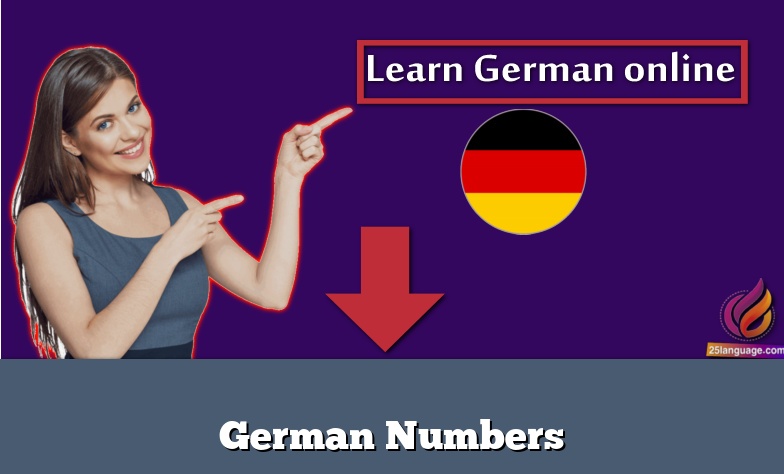German Numbers
German Numbers made Easy – Learn to count in German from 1-100 quickly

German Numbers. Learning numbers in German can be a bit tricky, so we will explain you how to count numbers in German step by step. It is recommended to memorize the numbers from 0 to 20. Once you learn these numbers, the rest of it is pretty easy. You just need to follow the pattern for the rest of the tens.
German Numbers from 0-10
Let’s start with learning numbers from 0 to 10. For a better learning experience, we have provided an audio below the table. Keep repeating the numbers with the audio until you learn them by heart!
| Number | English | German |
| 0 | zero | null |
| 1 | one | eins |
| 2 | two | zwei |
| 3 | three | drei |
| 4 | four | vier |
| 5 | five | fünf |
| 6 | six | sechs |
| 7 | seven | sieben |
| 8 | eight | acht |
| 9 | nine | neun |
| 10 | ten | zehn |
German Numbers from 11-20
In English, the numbers from 13 to 19 have the suffix “teen” at the end. Similarly, the German numbers from 13 to 19 have the suffix “zehn” in the end. Notice the pattern between both the languages and try to memorize the numbers.
Example:
In English, 3 is written as “three” and 13 is written as “thirteen”.
In German, 3 is written as “drei” and 13 is written as “dreizehn”.
We have repeated the previous numbers again below for reference and learning the numbers up to 20.
0 = null, 1 = eins, 2 = zwei, 3 = drei, 4 = vier, 5 = fünf, 6 = sechs, 7 = sieben, 8 = acht, 9 = neun, 10 = zehn
| Number | English | German |
| 11 | eleven | elf |
| 12 | twelve | zwölf |
| 13 | thirteen | dreizehn |
| 14 | fourteen | vierzehn |
| 15 | fifteen | fünfzehn |
| 16 | sixteen | sechzehn |
| 17 | seventeen | siebzehn |
| 18 | eighteen | achtzehn |
| 19 | nineteen | neunzehn |
| 20 | twenty | zwanzig |
The German NUMBERS FROM 0 TO 20
German Numbers from 21-30
The pattern after twenty changes a bit in comparison to English numbers. As per the positions of numbers, the number in the units place is written before the tens place in German.
This German number pattern can be compared to languages in the Devanagari script such as Hindi and Marathi.
Example:
In English, 21 is written as twenty-one.
In German, 21 is written as “einundzwanzig” which is literally “one and twenty”. Thus, the number in the units place is written before the tens place.
To simplify things for you, we would like to give an example here in Hindi as well as Marathi, just in case you know these languages.
In Hindi, 21 is written as इक्कीस. Similar to German, one is written before twenty in this case.
Similarly, in Marathi, 21 is written as एकवीस, where one is written before twenty again.
Repeating the numbers once more for the beginners.
0 = null, 1 = eins, 2 = zwei, 3 = drei, 4 = vier, 5 = fünf, 6 = sechs, 7 = sieben, 8 = acht, 9 = neun, 10 = zehn,
11 = elf, 12 = zwölf, 13 = dreizehn, 14 = vierzehn, 15 = fünfzehn, 16 = sechzehn, 17 = siebzehn, 18 = achtzehn, 19 = neunzehn, 20 = zwanzig,
| Number | English | German |
| 21 | twenty-one | einundzwanzig |
| 22 | twenty-two | zweiundzwanzig |
| 23 | twenty-three | dreiundzwanzig |
| 24 | twenty-four | vierundzwanzig |
| 25 | twenty-five | fünfundzwanzig |
| 26 | twenty-six | sechsundzwanzig |
| 27 | twenty-seven | siebenundzwanzig |
| 28 | twenty-eight | achtundzwanzig |
| 29 | twenty-nine | neunundzwanzig |
| 30 | thirty | dreißig |
German Numbers as Tens up to 100
The German tens are formed by adding the suffix “zig” at the end. The pattern varies a bit for 20, 30, 60, 70 and 100 for factors such as ease of pronunciation. Following are the numbers in German upto 100-
| Number | English | German |
| 10 | ten | zehn |
| 20 | twenty | zwanzig |
| 30 | thirty | dreißig |
| 40 | forty | vierzig |
| 50 | fifty | fünfzig |
| 60 | sixty | sechzig |
| 70 | seventy | siebzig |
| 80 | eighty | achtzig |
| 90 | ninety | neunzig |
| 100 | hundred | einhundert |
Now that you have learnt how to count in German from 1 to 100, we will see you next time with the numbers above 100.



























